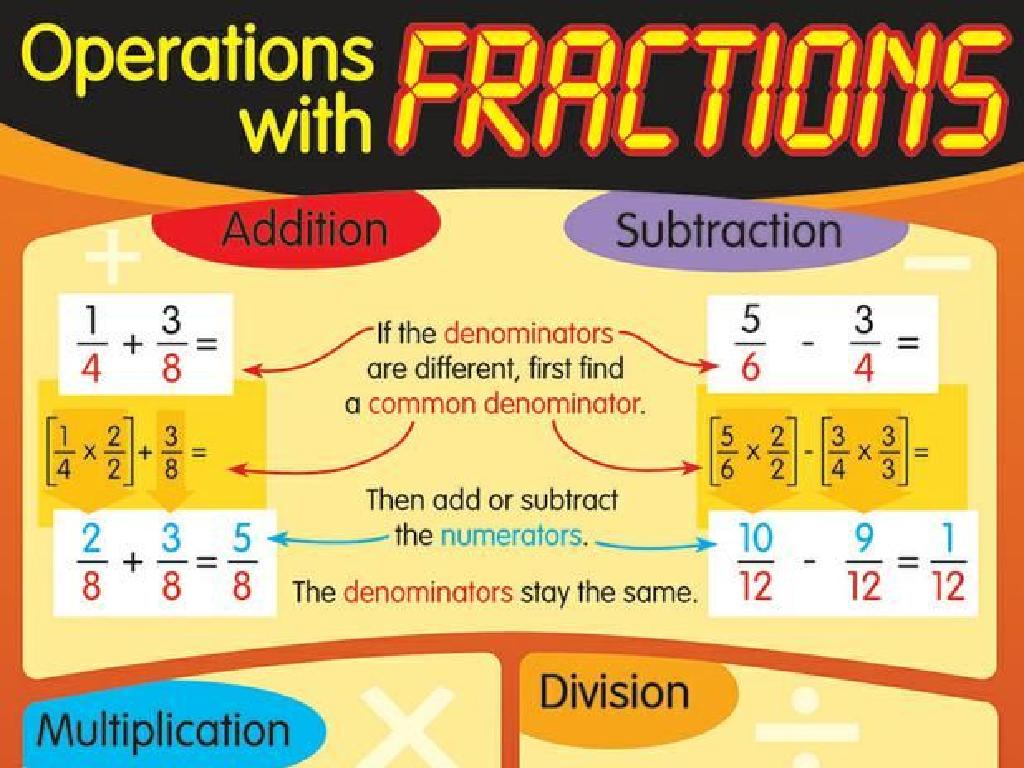Identify And Select Countries Of Asia: Region 6
Subject: Social studies
Grade: Sixth grade
Topic: Asia: Geography
Please LOG IN to download the presentation. Access is available to registered users only.
View More Content
Exploring Asia: Region 6
– Asia: Earth’s largest continent
– Diversity: Cultures, languages, landscapes
– Home to numerous cultures, over 2,300 languages, and varied landscapes from mountains to beaches.
– Region 6: A closer look
– Region 6 includes countries like Thailand, Vietnam, and Myanmar.
– Significance of regional study
– Understanding regions helps appreciate the continent’s complexity and interconnections.
|
This slide introduces students to Asia, the largest continent on Earth, setting the stage for a deeper dive into its diverse cultures, languages, and landscapes. Emphasize the vastness of Asia, which is home to more than half of the world’s population. Highlight the diversity found within this continent, from the numerous ethnic groups and languages to the variety of geographical features such as the Himalayas and tropical rainforests. Focus on Region 6, which includes Southeast Asian countries, and discuss its unique characteristics and importance. Encourage students to think about how studying individual regions can provide a clearer understanding of Asia’s role in global culture, economy, and politics. Prepare them for an engaging session where they will learn more about the specific countries within Region 6.
Exploring Asia: Focus on Region 6
– Locate Region 6 on Asia’s map
– List countries in Region 6
– Countries like Thailand, Vietnam, and Myanmar
– Describe Region 6 countries
– Thailand is known for its beautiful beaches and temples. Vietnam has a rich history and vibrant culture. Myanmar is famous for its ancient cities and pagodas.
– Share Region 6 interesting facts
– Did you know? Vietnam is the world’s largest exporter of cashews and black pepper!
|
This slide aims to help students identify and learn about the countries in Region 6 of Asia. Start by showing them how to find Region 6 on a map. Then, list the countries included in this region, such as Thailand, Vietnam, and Myanmar, providing a brief description of each to spark interest. Share interesting facts to make the learning process engaging, like Vietnam’s dominance in cashew and black pepper exports. Encourage students to research more about these countries to enhance their understanding of Asia’s geography.
Physical Features of Asia: Region 6
– Major mountains in Region 6
– Explore the Himalayas, Kunlun, and more
– Rivers and deserts of Region 6
– Discover the Ganges, Mekong rivers, and the Gobi Desert
– Impact on people’s lives
– How do these features affect agriculture, settlements, and culture?
– Activity: Matching features to countries
– Use a worksheet to connect physical features with their countries
|
This slide introduces students to the major physical features of Asia’s Region 6, including significant mountains like the Himalayas, important rivers such as the Ganges and Mekong, and large deserts like the Gobi. Discuss how these geographical features influence the daily lives of the people living in this region, including their agriculture, where they build homes, and their cultural practices. The class activity involves a worksheet where students will match each physical feature to the correct country on a map, reinforcing their knowledge of geography and the relationship between environment and human activity. For the activity, provide clear instructions and ensure the worksheet includes a variety of features to challenge the students. Encourage them to use atlases or online resources to assist in their matching.
Cultural Highlights of Asia: Region 6
– Explore languages and religions
– Learn about diverse languages like Mandarin, Hindi, and Arabic, and religions such as Buddhism, Islam, and Hinduism.
– Daily life cultural influences
– How do traditions shape food, clothing, and family life in different Asian countries?
– Class discussion on cultural diversity
– Discuss how our lives are similar or different from those in Asian countries.
– Compare and contrast with our culture
– Identify similarities in family values, holidays, and differences in daily routines and practices.
|
This slide aims to introduce students to the rich cultural tapestry of Asia’s Region 6. Begin by exploring the variety of languages spoken and the major religions practiced in this region. Discuss how these cultural elements influence the daily lives of people, from the food they eat to the clothes they wear and their family structures. Engage the class in a discussion to compare and contrast these cultural aspects with their own, fostering an understanding of diversity and global citizenship. Encourage students to be respectful and open-minded during the discussion. This activity will help students appreciate cultural differences and find common ground with other cultures.
Economic Overview of Asia: Region 6
– Introduction to Region 6 economies
– Major industries and trade
– Industries like technology, textiles, and agriculture dominate.
– Geography’s impact on economy
– Mountainous areas may focus on mining, while coastal areas may excel in fishing and shipping.
– Group discussion activity
|
This slide introduces students to the diverse economies of Asia’s Region 6, highlighting the variety of major industries and how trade is a crucial part of these economies. Emphasize the connection between a country’s geography and its economic focus, explaining how natural resources, terrain, and proximity to water bodies can influence the industries that thrive. For the group discussion activity, divide the class into small groups and assign each a different country from Region 6. Have them discuss and present how that country’s geography might affect its economy, encouraging them to consider factors such as natural resources, climate, and location. Provide a list of countries in Region 6 for reference.
Political Structure of Asia: Region 6
– Types of government in Region 6
– Monarchy, Democracy, Communism, etc.
– Government’s impact on daily life
– Laws, freedoms, services, and obligations
– Chart activity: Compare governments
– Create a chart of different governments and their characteristics
|
This slide introduces students to the various types of government found in Asia’s Region 6. Discuss examples like Monarchy, Democracy, and Communism, and how each system operates. Explain how the type of government affects the laws, freedoms, services provided to citizens, and their daily responsibilities. For the activity, guide students to create a chart comparing the different governments, focusing on key aspects such as leadership, citizen participation, and rights. This will help them understand the diversity of political structures and their tangible effects on people’s lives. Provide a template for the chart and examples of categories to compare. Encourage students to use creative visuals to represent each government type.
Environmental Issues in Asia: Region 6
– Current environmental concerns
– Pollution, deforestation, and climate change
– Global impact of these issues
– Affects weather patterns, global health, and economies
– Group brainstorm: solutions
– Work together to think of ways to address these problems
– Share & discuss findings
|
This slide aims to raise awareness among students about the environmental challenges faced by countries in Asia’s Region 6. Start by discussing specific issues such as pollution, deforestation, and the effects of climate change. Highlight how these issues do not exist in isolation and can influence global weather patterns, health, and economies. For the activity, divide the class into small groups and have them brainstorm potential solutions to these environmental problems. Encourage creativity and critical thinking. After the brainstorming session, each group will share their ideas with the class, fostering a collaborative learning environment. As a teacher, facilitate the discussion, guide the students to think globally, and emphasize the importance of individual and collective action.
Class Activity: Exploring Asia’s Region 6
– Interactive map identification
– Pair up for a map puzzle
– Work together to find where each country fits
– Complete the Region 6 puzzle
– Focus on countries in Asia’s Region 6
– Share discoveries with the class
– Discuss what you learned about these countries
|
This slide introduces an interactive class activity aimed at familiarizing students with the countries of Asia’s Region 6. Provide students with a map puzzle of Asia and have them work in pairs to identify and place each country in the correct location. This hands-on activity will help students better understand the geography of the region and how the countries are situated in relation to one another. After completing the puzzle, students should share their findings with the class, reflecting on any new information they learned or insights they gained about the region’s geography. This activity encourages teamwork, active learning, and public speaking skills. As a teacher, facilitate the activity by providing guidance and ensuring each pair has the necessary materials. Be prepared to offer hints or corrections as needed.
Conclusion & Reflection: Asia’s Region 6
– Recap of Region 6 in Asia
– Geography’s influence on culture & economy
– How mountains, rivers, and climate shape the way people live and work
– Write a reflective paragraph
– Reflect on one new fact or idea from today’s lesson
– Share your insights tomorrow
– Be prepared to discuss your thoughts in class
|
This slide aims to wrap up the lesson by summarizing the key points about Asia’s Region 6. Emphasize the connection between geography and the development of cultural and economic practices in the region. Encourage students to reflect on the material by writing a paragraph about something new they learned, which could be about a specific country, a geographical feature, or how the environment affects daily life. This exercise will help solidify their understanding and allow them to share their perspectives. In the next class, create an open forum for students to express their findings and engage in a discussion to promote active learning.






